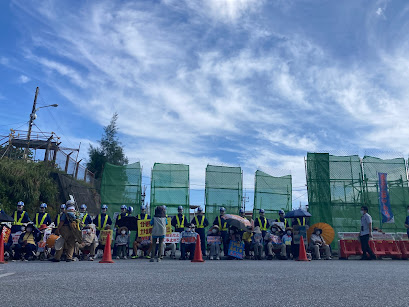Connecting to the International Community: Public Comment Period on the Defense Bureau's Application for Change in Henoko Base Construction Starts
On September 8, 2020, the Okinawa Prefectural Government began its three-week public review and comment period on the Okinawa Defense Bureau's application for change in construction design and work for the Futenma Replacement Facility (commonly known as Henoko new base) now under construction at Henoko-Oura Bay in northern Okinawa.
 |
| Beautiful Oura Bay on September 4, 2020 All construction vessels left the bay in advance of Typhoon Haishen |
The public review and comment period is part of the prefectural government's review process of the Bureau's application under the Public Water Reclamation Act. The prefectural government will be collecting public comments until September 28. Incorporating them, Okinawa Governor Denny Tamaki will then decide to approve or reject the application in the next three to six months; Governor Tamaki is expected to reject the application.
The Defense Bureau submitted its application in April 2020 as it admitted that the seafloor at the Oura Bay side of the construction site is extremely fragile, with its N value being zero or with mayonnaise-like consistency; the seafloor requires major reinforcement work. The application documents consist of two parts. One deals with land reclamation work including seafloor reinforcement work and the other is an environmental impact study. However, both appear to lack details (I will provide more on this later).
The Bureau's December 2019 documents indicated that 71,000 piles would be implanted into the seafloor as deep as 300 feet below the water surface. Accordingly, the base's completion date has been pushed from 2022 or 2026 as initially spelled out to sometime in the 2030s. They concluded that, with its mitigation measures, there would be no adverse impacts on the environment from reinforcement and construction work. The application documents reiterate the same conclusion.
 |
| Cross Section Rendering of Pile Implanting at the Oura Side |
The Okinawa Environmental Justice Project has argued that the Bureau's no-adverse-impacts conclusion does not hold. Its construction work has already brought tremendous impacts on the environment (see our report on the dugong). The proposed reinforcement work will create further damage to the environment.
Also, civil engineering experts have warned that because of the fragile seafloor "the planned seawalls for the base will probably collapse even with an earthquake with level 1 intensity." The fact that the Bureau had to submit this new application at this point is a clear indication that the Bureau's studies, including its 2012 Environmental Impact Assessment, are flawed and this project is just reckless.
The public comment period and the prefectural government's review process provide a critical juncture for this twenty-three-year saga of the Henoko project; various battles will take place and intensify. Okinawa's democratic voice continues to challenge the Japanese government's push for construction. Scientists, experts, and NGOs challenge the Defense Bureau's no-adverse-impacts conclusion and take on safety issues. Governor Tamaki's expected rejection of the Bureau's application will be likely followed by a series of lawsuits and counter lawsuits between the Japanese government and Okinawa prefectural government. It is also expected that the Bureau will continue construction work until Governor Tamaki formally makes his decision.
What are at stake are not only Okinawa's democratic voice and the precious environment of Henoko-Oura Bay but also the integrity of the Japanese and U.S. governments as "democratic and law-abiding countries" in the eyes of the international community.
The Okinawa Environmental Justice Project will provide updates as this critical juncture unfolds, including more details of the Bureau's application documents. We also encourage international civil society members to support Okinawa's democratic voice against the base construction and efforts to protect Henoko-Oura Bay by writing letters to relevant organizations, including the Okinawa prefectural government and the Japanese government. We especially encourage U.S. citizens to convey the issues to your Congress members.
Hideki Yoshikawa
Director
Okinawa Environmental Justice Project


